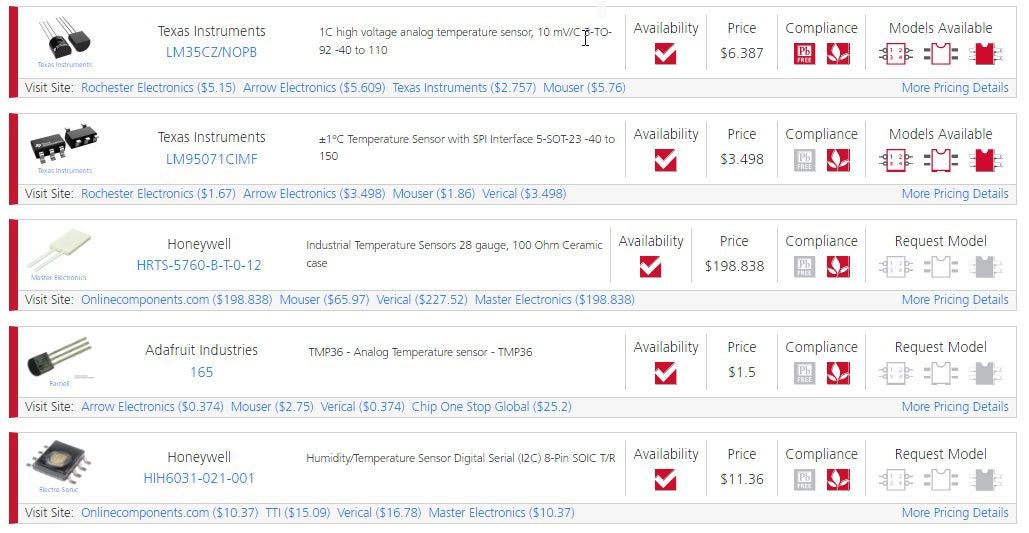Today you can find electronics and circuit boards virtually everywhere. This includes commercial products, industrial equipment, transportation vehicles, and aerospace platforms. Although these varied applications may utilize similar electronic components, the environments they must operate in are often quite different.
For example, some components and boards must function reliably in automotive systems where vibration and/or constant motion is a contention, while others must operate in the harsh environment of space. In these and other surroundings where extreme heat and/or cold may be present accurate temperature measurements are critical. There are several different temperature sensor types, each with preferential applications to meet this need.
What are Temperature Sensors?
Next to common passive electronic components, such as resistors and capacitors, sensors are probably the most used parts on circuit boards and electronic systems. Common sensor types include resistive, capacitive, inductive, ultrasonic, and Hall effect, often used in motor control circuits. These components measure various properties of nearby devices or the environment in which they are installed or operated. Examples include vibration, force, pressure, position, fluid, optical, and temperature.
Temperature sensors are somewhat unique in that they can be applied almost anywhere and measure any matter. This includes security monitoring and control to detect contingencies such as smoke and fire. They can also be used for data acquisition and gathering in wearables or medical devices. These versatile parts can be defined as:
| Definition:
Temperature sensors are devices capable of measuring the thermal properties of physical elements, liquids, and/or gasses via direct contact, optical interaction, or acoustics. Typically, the sensed parameters are converted into electrical signals that can be processed graphically or numerically on one of the common temperature scales–℉, ℃ , or Kelvin. |
As the possible applications for temperature sensors are broad, there are many temperature sensor types.
Different Temperature Sensor Types
Temperature sensors are widely applied and perform critical functions for many systems. For example, it is almost universally mandated that residences have devices for detecting smoke, and many industrial facilities must have devices that can detect elevated radiation. These sensors are also primary components in environment control applications, such as heating, ventilation, and air conditioning (HVAC) systems.
The types of temperature sensors commonly utilized include the following:
Temperature Sensor Types
- Thermocouple
Thermocouples, probably the most implemented type of temperature sensor, are based upon the Seebeck effect. Using two different conductor materials creates a voltage differential that is proportional to the variance in temperature.
- Resistance temperature detector (RTD)
RTDs are also commonly used. Here, the relationship between changing temperature and resistance for metals is utilized. The most common metal used is platinum.
- Thermistor
Thermistors are also based on a change in resistance. As a result, these devices are susceptible and can detect minimal temperature changes. Often, these components are used in temperature control applications.
- Thermopile (infrared thermal sensor)
Thermopiles are non-contact sensors that can have ranges up to several meters. Typically, these devices use infrared detection. These sensors may be assembled in arrays, such as for the MLX90640.
- Digital thermal sensor
With the increasing use of IoT architectures, more digital thermal sensors are being applied. These ICs are commonly used in smart appliances and medical devices.
As with many electronic components in today’s climate, it is advisable to have a good component management strategy to ensure that component supply chain challenges do not adversely impact your design.
The Best Way to Source Temperature Sensors
When designing PCBAs that incorporate on-board or off-board temperature sensor types, it is important that you utilize a reliable source that includes accurate and real time data and information. It is also important that your source provides a variety of options, as shown below, with helpful comparisons to assist you in choosing the best component for your design.

UL listing of different temperature sensor types
In addition to listings, as shown above, UL also provides important design data, such as schematic symbols, board footprints, and 3D models for your ECAD/MCAD integration.
If you’re looking for CAD models for common components, such as temperature sensor types, Ultra Librarian helps by compiling all your sourcing and CAD information in one place. Working with Ultra Librarian sets up your team for success to ensure streamlined and error-free design, production, and sourcing. Register today for free.








